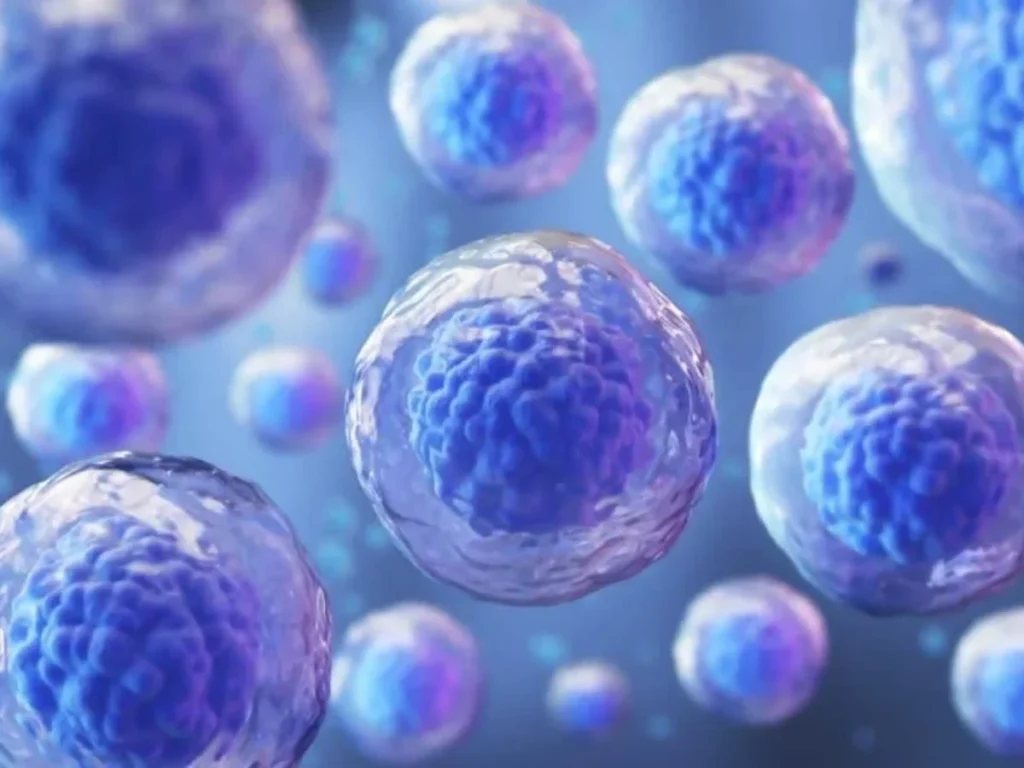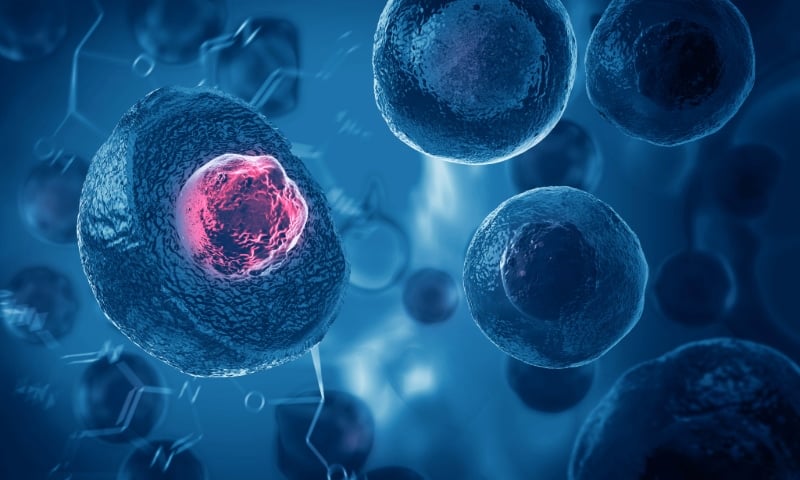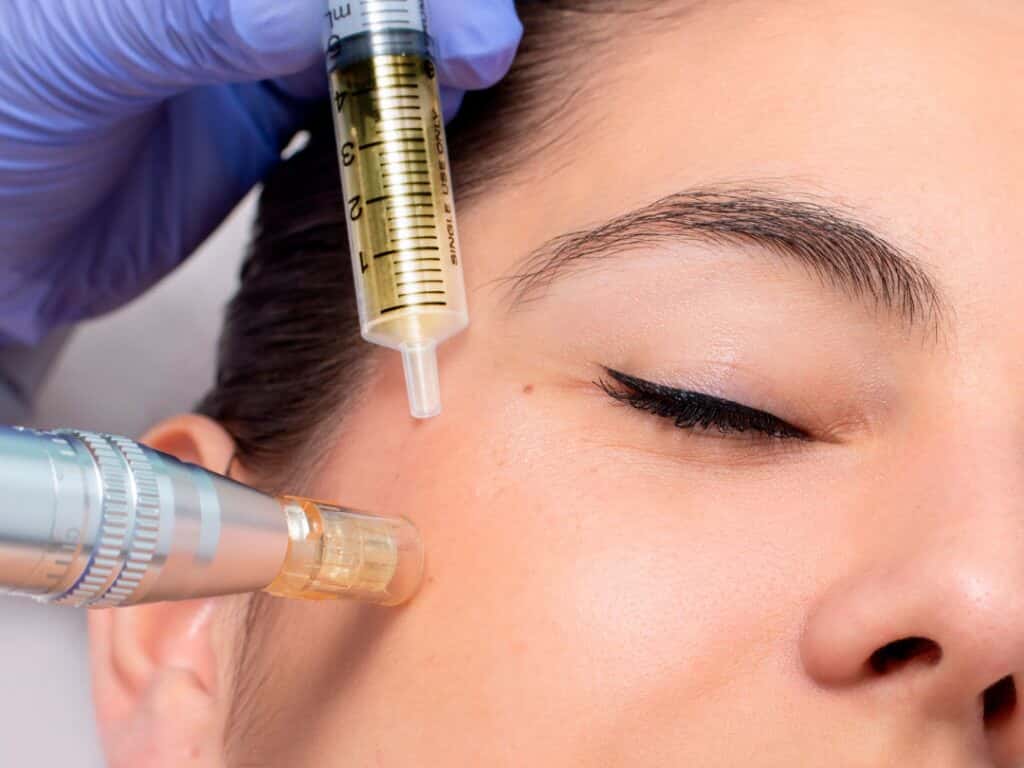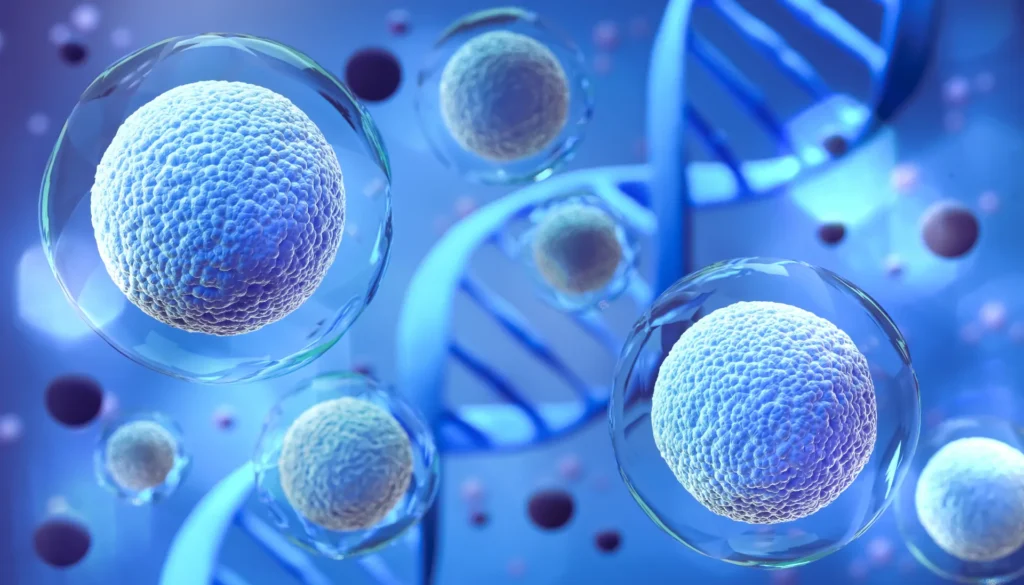The exosomes used in aesthetic medicine are nanometric extracellular vesicles (30 to 150 nm) that are used in the derived from stem cellsnormally mesenchymal (such as from adipose tissue, umbilical cord or bone marrow). Their exact composition and origin depends on the manufacturer, but in general terms, they are made of:
1. Lipids
- They form the outer membrane of the exosome, a lipid bilayer similar to that of cells.
- They protect the inner contents and allow fusion with other cells.
2. Proteins
- They include:
- Surface markers such as CD9, CD63 and CD81.
- Growth factors (TGF-β, IGF, EGF, FGF).
- Cytokines and chemokines that modulate inflammation and regeneration.
Nucleic acids
- Small fragments of Messenger RNA (mRNA) y microRNA (miRNA).
- They are involved in the genetic regulation of host cells.
4. Bioactive molecules
- Enzymes, metabolites and other regenerative substances that help stimulate processes such as collagen formation, angiogenesis, cell repair, etc.
Where are commercial exosomes obtained from?
- Culturing human mesenchymal stem cells in the laboratory.
- The following is collected conditioned environmentwhich contains the exosomes secreted by these cells.
- They are then isolated and purified by methods such as ultracentrifugation or filtration.
Key issues to consider:
- They do not contain living cellsonly the vesicles and their bioactive content.
- The efficacy and safety depend on the type of stem cells of origin, the isolation process, the purity of the product and its clinical use.
- Some products sold as 'exosomes' may contain mixtures of extracellular vesicles or other components, not always well defined or regulated.

DIFFERENCES BETWEEN EXOSOMES AND STEM CELLS
- ExosomesThey are like "molecular messengers" sent by stem cells. They do not regenerate tissue on their own, but stimulate other cells to do so.
- Stem cellsThey are "specialised workers" who can build new cell structures as well as send signals.
The difference between exosomes y stem cells (or "staminal" cells, from Italian) is highly significantThe structure, function and therapeutic application:
| BIOLOGICAL NATURE | Exosomes | Stem cells |
|---|---|---|
| Type | Extracellular vesicles (without nucleus and complete DNA) | Whole living cells |
| Origin | Secreted by cells (including stem cells) | Primary cells with capacity for self-renewal and differentiation |
| Size | 30-150 nanometres | 10-30 micrometers |
| CONTENTS | Exosomes | Stem cells |
|---|---|---|
| Contain | Lipids, proteins, RNA (miRNA, mRNA), growth factors | Nucleus, complete DNA, cell organelles |
| Genetic capacity | Cannot be replicated or differentiated | They can replicate and differentiate into other cell types. |
| THERAPEUTIC FUNCTION | Exosomes | Stem cells |
|---|---|---|
| Action | intercellular communication: modulate processes such as inflammation, regeneration, pigmentation, ageing | Direct tissue regeneration via cell differentiation and also via paracrine (secrete exosomes and other factors). |
| Aesthetic use | Stimulate collagen production, reduce inflammation, improve skin texture and pigmentation. | Deeper repair: can regenerate tissues, but require more control and regulation |
| Immunogenicity | Low or non-existent (not living cells) | There may be immunological risk if they are not autologous (from the same patient). |
| SAFETY AND REGULATION | Exosomes | Stem cells |
|---|---|---|
| Tumour risk | Null | Potential if used incorrectly |
| Regulation | In many countries, such as Spain, they are not yet clearly regulated (legal grey zone). | They are heavily regulated by health authorities (FDA, EMA, AEMPS, etc.). |

The origin of exosomes and stem cells can be human or animalbut for applications medical and aesthetic in humansThe prefers (and in many countries it is requires) that are of human origin. I will explain in detail:
| STEM CELLS - Possible origin | Description | Use in aesthetic medicine |
|---|---|---|
| Human (autologous) | Taken from the patient's own body (fat, bone marrow, blood) | Very safe; no risk of rejection. Applications in tissue regeneration, facial, capillary. |
| Human (allogeneic) | From human donors (umbilical cord, placenta, bone marrow) | Widely used in advanced cosmetics and regenerative medicine. They need good purification and certification. |
| Animal (xenogenic) | Derived from animal species (rare in whole stem cells) | Uncommon in aesthetics due to immunological and ethical risks. More common in basic research. |
| EXOSOMAS - Possible origin | Description | Use in aesthetic medicine |
|---|---|---|
| Human (frequent) | Secreted by human stem cells in the laboratory (especially from umbilical cord or adipose tissue) | Most commonly used in commercial aesthetic products. Must be well purified and free of residual DNA. |
| Animal (less common) | Secreted by animal cells (e.g. foetal bovine serum) | Sometimes used in topical cosmetics (non-injectable). Not recommended for clinical use in humans. |
| Synthetics or hybrids | Mimic natural exosomes (lipid nanoparticles) | Developing. Not yet a major commercial presence. |
Beware of mislabelled products
Some cosmetic products that claim to contain "exosomes" actually contain cell lysate, bovine serum o cell fragmentsnot actual purified exosomes. It is important that:
- The product indicates the cellular origin.
- Be certified with valid insulation methods.
- Do not contain DNAlive cells and infectious agents.
- Have record or documentation to support it as a cosmetic or medical use.
| RESUMING | Stem cells | Exosomes |
|---|---|---|
| Human origin | The most common and recommended | The most common and recommended |
| Animal origin | Little used in humans; more common in research | Can be found in non-injectable topical cosmetics |
| Aesthetic preference | Human (autologous or allogeneic) | Human (allogeneic, usually) |

In order for the exosomes be effective in aesthetic treatmentsmust achieve the dermiswhich is where the fibroblasts responsible for the production of collagen, elastin and hyaluronic acid. The simple surface application is not enough in most cases if a deep regenerative effect is sought.
How deep should they go?
- Therapeutic objective: to reach the reticular or papillary dermis (between 1 and 2 mm deep), where fibroblasts and vascular structures are found.
- If the exosomes remain in the epidermis (outermost layer, <0.2 mm), their absorption is minimal and limited to a mild cosmetic effect.
How are exosomes applied in aesthetics?
1. Microneedling (Dermapen or roller)
- Most common and effective technique.
- Microchannels are created in the skin (0.5-2 mm deep) and then the exosomes are applied topically.
- Promotes its penetration into the dermis.
- Ideal for: facial rejuvenation, spots, pores, texture, alopecia.
2. Mesotherapy (intradermal injection)
- The exosomes are injected directly into the dermis by means of microinjections (nappage or point-to-point technique).
- A very fine needle (32G or similar) is used.
- Advantage: direct and localised delivery.
- Ideal for: fine wrinkles, firmness, eye contour, neck, scars.
3. Electroporation or mesopores
- A device that applies a low-intensity electrical current to temporarily open cell channels.
- Improves penetration without the need for needles.
- Moderate efficacy, shallower than injection.
- Ideal for needle-averse patients.
4. Fractional laser + topical application
- The laser creates micro-injuries that increase transepidermal absorption.
- Exosomes are then applied to enhance regeneration.
- Very common in advanced clinics.
5. Topical use (without devices)
- Creams, serums or masks with exosomes.
- Its action is limited if not accompanied by penetration techniques.
- Useful as maintenance after deeper treatments.
Read before use
- Injectable exosomesmust be formulated and certified to intradermal medical use. Not all products for "cosmetic use" are authorised for injection.
- Sterility and conservationExosomes are sensitive to heat and light. They are usually kept cold and must be applied under strict aseptic conditions.
- Recommended frequency3 to 5 sessions at intervals of 2 to 4 weeks, depending on the protocol and indication.
| Method | Depth | Effectiveness | Common indications |
|---|---|---|---|
| Microneedling | 0,5-2 mm | High | Rejuvenation, alopecia |
| Mesotherapy | 1-2 mm | Very high | Wrinkles, firmness, spots |
| Electroporation | 0,5-1 mm | Media | Gentle firming |
| Topical (without apparatus) | Epidermis | Baja | Post-treatment maintenance |






